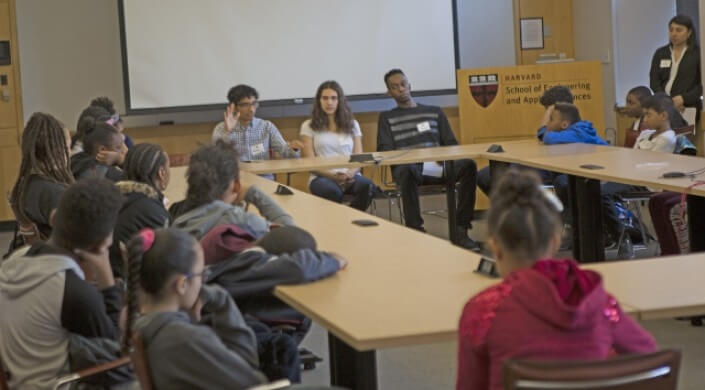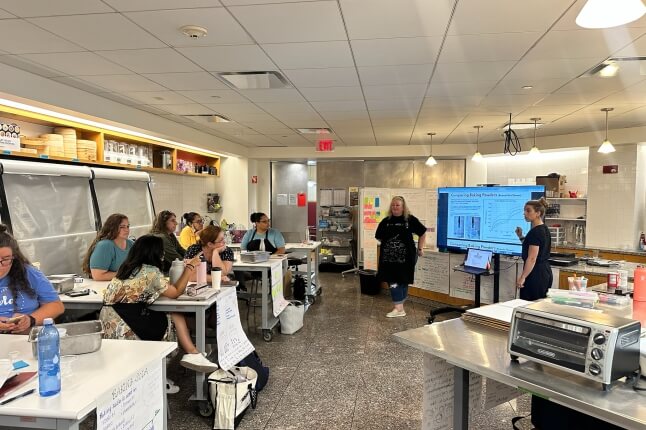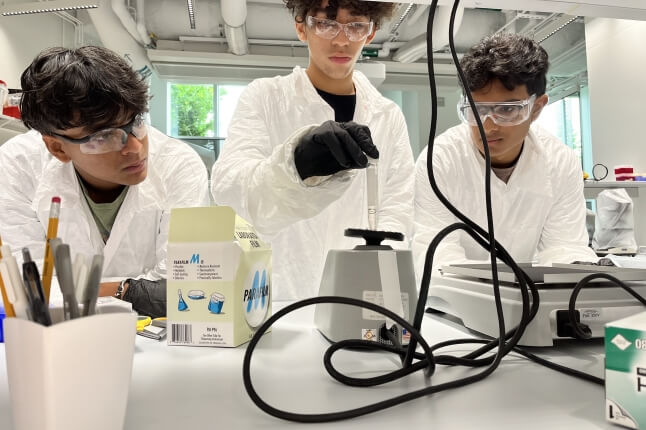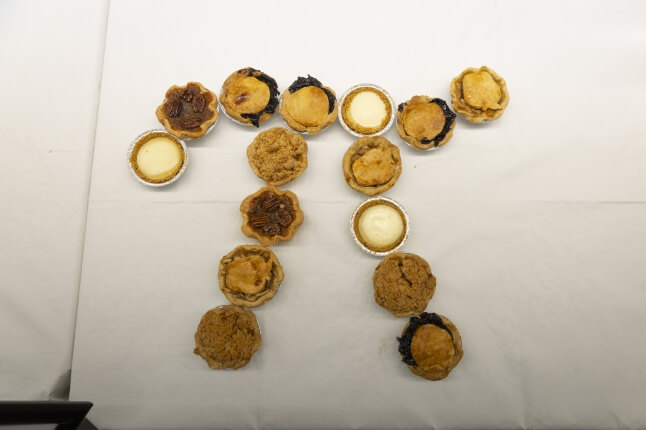News
Student panelists, Harshal Singh, A.B. ’20, a computer science concentrator, Jasmine Schlichting, A.B. ’19, a physics concentrator, and Sayo Eweje, S.B. ’19, a bioengineering concentrator, share their experiences at Harvard with young visitors. (Photo by Alana Davitt/SEAS Communications)
“Have you ever made something that never existed before?” asked a young student on the edge of his seat.
The adolescent inquisitor was among a group of middle school students from a camp at the Thomas M. Menino YMCA in Boston's Hyde Park neighborhood who recently visited the Harvard campus for an inside look at the John A. Paulson School of Engineering and Applied Sciences (SEAS).
“When you do research, you’re working in a lab where you investigate a problem. Then you can make new things to solve it,” answered Sayo Eweje, S.B. ’19, a bioengineering concentrator who conducts research in the lab of Kit Parker, Tarr Family Professor of Bioengineering and Applied Physics at SEAS.
The campus visit, organized by Kathryn Holler, Director of Community Engagement and Diversity Outreach, began with a panel discussion from current undergraduates, including Eweje, Jasmine Schlichting, A.B. ’19, a physics concentrator, and Harshal Singh, A.B. ’20, a computer science concentrator. The panel discussed many of the most pertinent topics for students considering college and future STEM careers.
When asked about her favorite aspect of life at Harvard, Schlichting responded, “The people you meet. Every person here is one of the most interesting people I’ve met.”
Singh, on the other hand, said, “Every day in college I learn something new, something I could have never known before.”
With the close of the formal presentation and the arrival of a pizza lunch, the middle schoolers had further opportunities to connect with panelists. The students wanted to know everything, from how the undergrads decided on their course of study, to the kinds of experiments they perform, to an explanation of how a solar battery works.
A common theme among the group, besides a genuine interest in the work and advice of the SEAS students, was an uneasiness about choosing a field of study and a career. One middle school student said that she wanted to be both a scientist and an artist.
“You don’t have to choose one thing—smart or pretty or athletic. You can have it all,” said Schlichting, offering advice she would have given to her middle school self.
With the pizzas devoured, Eweje took the group on a brief tour of Pierce Hall, which houses the Active Learning Labs and contains displays of many SEAS class projects. The students conducted a few hands-on science experiments to close out the afternoon.
When asked about what he hoped the young students took away from the day’s events, Eweje said, “I think that through learning about our experiences, they got a more tangible understanding of what ‘doing science’ means and how they can be scientists and engineers in their own way. It could mean designing cars, building robots, analyzing cells and tissues, but it’s not just the standard ‘mixing things in test tubes’ that I thought of as a kid. Getting that perspective, even if it was just in a small way, is definitely valuable.”
Topics: K-12
Cutting-edge science delivered direct to your inbox.
Join the Harvard SEAS mailing list.
Press Contact
Adam Zewe | 617-496-5878 | azewe@seas.harvard.edu



